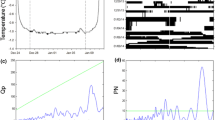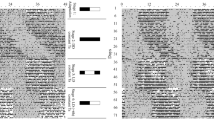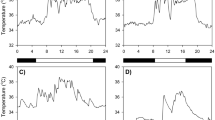Abstract
Entrainment patterns of the circadian rhythms of body temperature and locomotor activity were compared in 6 squirrel monkeys (Saimiri sciureus) exposed to daily illumination cycles with abrupt transitions between light and darkness (LD-rectangular) or with gradual dawn and dusk transitions simulating natural twilights at the equator (LD-twilight). Daytime light intensity was 500 lux, and the total amount of light emitted per day was the same in the two conditions. Mean daytime body temperature levels were stable in LD-rectangular but increased gradually in LD-twilight, reaching peak levels during the dusk twilight. Locomotor activity showed a similar pattern, but with an additional, secondary peak near the end of dawn. Activity duration was about 0.5 h longer in LD-twilight than in LD-rectangular, but the time of activity midpoint was similar in the two conditions. Reentrainment of the body temperature rhythm was faster following an 8-h advance of the LD cycle than following an 8-h delay, but did not differ significantly between the two LD conditions. These results provide no evidence that the inclusion of twilight transitions affected the strength of the LD Zeitgeber, and suggest that the observed differences in the daily patterns reflected direct effects of light intensity on locomotor activity and body temperature rather than an effect of twilights on circadian entrainment mechanisms.
Similar content being viewed by others
Abbreviations
- LD :
-
light-dark
References
Aschoff J (1978) Problems of re-entrainment of circadian rhythms: asymmetry effect, dissociation and partition. In: Assenmacher I, Farner DS (eds) Environmental endocrinology. Springer, New York, pp 185–195
Aschoff J, Wever R (1965) Circadian rhythms of finches in light-dark cycles with interposed twilights. Comp Biochem Physiol 16: 507–514
Aschoff J, Hoffmann K, Pohl H, Wever R (1975) Re-entrainment of circadian rhythms after phase-shifts of the Zeitgeber. Chronobiologia 2: 23–78
Balwin JD, Baldwin J (1972) The ecology and behavior of squirrel monkeys (Saimiri oerstedi) in a natural forest in Western Panama. Folia Primatol 18: 161–184
Boulos Z, Houpt TA (1994) Failure of triazolam to alter circadian reentrainment rates in squirrel monkeys. Pharmacol Biochem Behav 47: 471–476
Boulos Z, Terman JS, Terman M (1992) Phase response curves for simulated dawn and dusk pulses in hamsters. Soc Res Biol Rhythms Abstr 3: 63
Daan S (1977) Tonic and phasic effects of light on the entrainment of circadian rhythms. Ann NY Acad Sci 290: 51–59
Daan S, Aschoff J (1975) Circadian rhythms of locomotor activity in captive birds and mammals: their variations with season and latitude. Oecologia 18: 269–316
Daan S, Pittendrigh CS (1976) A functional analysis of circadian pacemakers in nocturnal rodents. II. The variability of phase response curves. J Comp Physiol 106: 253–266
DeCoursey PJ (1961) Effect of light on the circadian activity rhythms of the flying squirrel, Glaucomys volans. Z Vergl Physiol 44: 331–354
DeCoursey PJ (1964) Daily light sensitivity rhythms in a rodent. Science 131: 33–35
DeCoursey PJ (1972) LD ratios and the entrainment of circadian activity in a nocturnal and a diurnal rodent. J Comp Physiol 78: 221–235
DeCoursey PJ (1986) Light-sampling behavior in photoentrainment of a rodent circadian rhythm. J Comp Physiol A 159: 161–169
DeCoursey PJ (1989) Photoentrainment of circadian rhythms: an ecologist's viewpoint. In: Hiroshige T, Honma K (eds) Circadian clocks and ecology. Hokkaido Univ Press, Sapporo, pp 187–206
DuMond FV (1968) The squirrel monkey in a seminatural environment. In: Rosenblum LA, Cooper RW (eds) The squirrel monkey. Academic Press, New York London, pp 87–145
Erkert (1976) Lunarperiodic variation of the phase-angle difference in nocturnal animals under natural Zeitgeber-conditions near the equator. Int J Chronobiol 4: 125–138
Erkert HG (1989) Lighting requirements of nocturnal primates in captivity: a chronobiological approach. Zoo Biol 8: 179–191
Erkert HG, Gröber J (1986) Direct modulation of activity and body temperature of owl monkeys (Aotus lemurinus griseimembra) by low light intensities. Folia Primatol 47: 171–188
Erkert HG, Thiemann A (1981) Zeitgeber-schedule dependent resynchronization of circadian rhythms in nocturnal mammals (Primates and Chiroptera). Experientia 37: 983–984
Erkinaro E (1970) Wirkung von Tageslänge und Dämmerung auf die Phasenlage der 24-h Periodik der Waldmaus Apodemus flavicollis Melch. im Naturtag. Oikos [Suppl] 13: 101–107
Gander PH, Moore-Ede MC (1983) Light-dark masking of circadian temperature and activity rhythms in squirrel monkeys. Am J Physiol 245: R927-R934
Hammond RD, Naylor E (1977) Effects of dusk and dawn on locomotor activity rhythms in the Norway lobster Nephrops norvegieus. Marine Biol 39: 253–260
Hoban TM, Sulzman FM (1985) Light effects on circadian timing system of a diurnal primate, the squirrel monkey. Am J Physiol 249: R274-R280
Hughes PC, Bickford EW, Goldstein IS (1987) Optical radiation. Pineal Res Rev 5: 1–67
Kavaliers M, Ross DM (1981) Twilight and day length affects the seasonality of entrainment and endogenous circadian rhythms in a fish, Couesius plumbeus. Can J Zool 59: 1326–1334
Kavanau JL (1962a) Twilight transitions and biological rhythmicity. Nature 194: 346–348
Kavanau JL (1962b) Activity pattern on regimes employing artificial twilight transitions. Experientia 18: 382–384
Kavanau JL (1968) Activity and orientational responses of whitefooted mice to light. Nature 218: 245–252
Kavanau JL (1969) Influences of light on activity of small animals. Ecology 50: 548–557
Kavanau JL, Peters CP (1974) Primate locomotor pattern repetitions, program clocks, and orientation to light. Primates 15: 209–217
Kavanau JL, Peters CR (1976) Twilight Zeitgebers, weather, and activity of nocturnal primates. Folia Primatol 26: 67–79
Kavanau JL, Ramos J (1970) Roadrunners: activity of captive individuals. Science 169: 780–782
Kavanau JL, Ramos J (1972) Twilights and onset and cessation of carnivore activity. J Wildlife Management 36: 653–657
Kavanau JL, Ramos J (1975) Influences of light on activity and phasing of carnivores. Am Naturalist 109: 391–418
Kenagy GJ (1976) The periodicity of daily activity and its seasonal changes in free-ranging and captive kangaroo rats. Oecologia 24: 105–140
Macchi M, Boulos Z, Terman M (1996) Twilight transitions promote entrainment to lengthening LD cycles. Soc Res Biol Rhythms Abstr 5: 106
Mech LD, Heezen KL, Siniff DB (1966) Onset and cessation of activity in cottontail rabbits and snowshoe hares in relation to sunset and sunrise. Anim Behav 14: 410–413
Meijer JH, Rusak B, Harrington ME (1989) Photically responsive neurons in the hypothalamus of a diurnal ground squirrel. Brain Res 501: 315–323
Nelson DE, Takahashi JS (1991) Sensitivity and integration in a visual pathway for circadian entrainment in the hamster (Mesocricetus auratus). J Physiol (Lond) 439: 115–145
Pariente G-F (1975) Lumière et rythme d'activité de Phaner furcifer (Prosimien nocturne de Madagascar) dans son milieu naturel. J Physiol (Paris) 70: 637–647
Pittendrigh CS, Daan S (1976) A functional analysis of circadian pacemakers in nocturnal rodents. IV. Entrainment: pacemaker as clock. J Comp Physiol 106: 291–331
Pohl H (1978) Comparative aspects of circadian rhythms in homeotherms. Re-entrainment after phase shifts of the Zeitgeber. Int J Chronobiol 5: 493–517
Pohl H (1982) Characteristics and variability in entrainment of circadian rhythms to light in diurnal rodents. In: Aschoff J, Daan S, Groos G (eds) Vertebrate circadian systems: structure and physiology. Springer, Berlin Heidelberg New York, pp 339–346
Pohl H (1983) Light pulses entrain the circadian activity rhythm of a diurnal rodent (Ammospermophilus leucurus). Comp Biochem Physiol 76B: 723–729
Rietveld WJ, Tordoir WEM (1965) The influence of twilight duration on locomotor activity of rabbits. Acta Physiol Pharmacol Neerl 14: 467–475
Sulzman FM, Fuller CA, Moore-Ede MC (1979) Tonic effects of light on the circadian system of the squirrel monkey. J Comp Physiol 129: 43–50
Terman M, Remé C, Wirz-Justice A (1991) The visual input stage of the mammalian circadian pacemaking system. II. The effect of light and drugs on retinal function. J Biol Rhythms 6: 31–48
Terman M, Terman JS, Fairhurst S (1990) Circadian adjustment to a seasonally-modulated naturalistic lighting environment. Soc Res Biol Rhythms Abstr 2: 31
Thorington L (1980) Actinic effects of light and biological implications. Photochem Photobiol 32: 117–129
Thorington RW Jr (1985) The taxonomy and distribution of squirrel monkeys (Saimiri). In: Rosenblum LA, Coe CL (eds) Handbook of squirrel monkey research. Plenum Press, New York London, pp 1–33
Wever R (1965) A mathematical model for circadian rhythms. In: Aschoff J (ed) Circadian clocks. North-Holland, Amsterdam, pp 47–63
Wexler DB, Moore-Ede MC (1986) Resynchronization of circadian sleep-wake and temperature cycles in the squirrel monkey following phase shifts of the environmental light-dark cycle. Aviat Space Environ Med 57: 1144–1149
Author information
Authors and Affiliations
Rights and permissions
About this article
Cite this article
Boulos, Z., Macchi, M. & Terman, M. Effects of twilights on circadian entrainment patterns and reentrainment rates in squirrel monkeys. J Comp Physiol A 179, 687–694 (1996). https://doi.org/10.1007/BF00216132
Accepted:
Issue Date:
DOI: https://doi.org/10.1007/BF00216132




